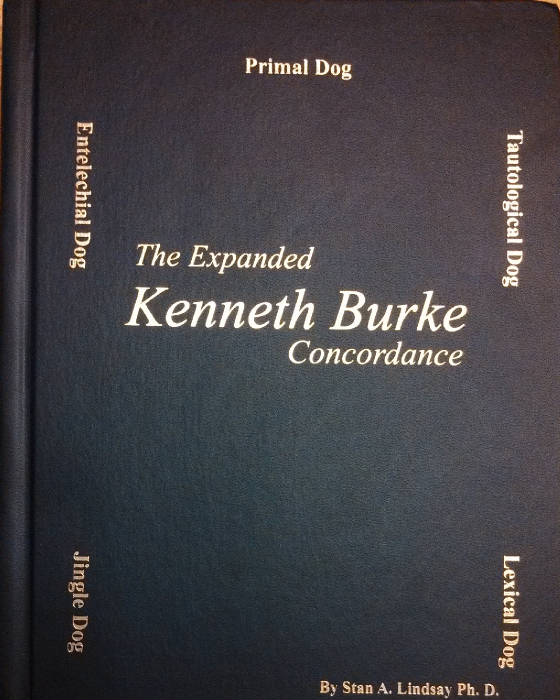|
| undefined |

|
| undefined |
THE EXPANDED KENNETH
BURKE CONCORDANCE by Stan A. Lindsay Five Times the number of page listings as in the "Concise" concordance! EVERY SINGLE TERM BURKE LISTS in his own listings is DIGITALLY SEARCHED ALL OF BURKE'S BOOKS and MOST OF HIS ARTICLES are searched! (Nearly 10,000 listed terms and over 200,000 page locations) VIRTUALLY ALL of Burke's MAJOR CONCEPTS are digitally searched!
A
CONCISE KENNETH BURKE CONCORDANCE
by
Stan A. Lindsay
Compiling (and using) a Burkean concordance
is similar to mining for gold in the hills of California. Every now and then, you strike a vein and find a tremendous payload.
At other times, you must learn to meticulously and systematically trace Burke’s symbolic treasures through the “labyrinthine
streets” of Burke’s terminology. (We know that we just used a mixed metaphor [partly from Burke], but you get
the idea.) You must understand his method of charting equations and apply that method to his own works: “Use all that
is there to use.” Hence, we have included many notations throughout this concordance.
Despite the fact
that this concordance contains over 4000 listed terms and over 45,000 page locations, there is much more to be found. In
the margins between the listings in this concordance, you will find some room to jot down Burkean terms you personally have
“discovered,” page locations you find useful, etc. If you are willing to share your discoveries with us, we will
attempt to make them part of any future editions of this concordance. Just email them to us at saypresscom@yahoo.com, preferably
stating that we have your permission to include your discoveries in future editions of the concordance.
Burke’s
influence is strongly felt in the areas of Rhetoric (in both English and Speech Communication departments), communication,
the business field, and biblical studies. According to Hugh Duncan in, other fields in which Burke’s influence has
been felt are: Sociology, Literature, Philosophy, Music, Psychology, Anthropology, History, Art, and Religion. According
to Benedict Giamo, his interdisciplinary range even includes forays into the sciences. This list is illustrative, not exhaustive.
Our hope is that A Concise Kenneth Burke Concordance will serve as a useful tool
To those who are
new to Burke’s writings (as an aid to help you fight your way through very difficult reading material) and
To
those who are well-versed in Burke’s writings (as an aid to help you organize your vast accumulation of terms and concepts
from this thinker).
We hope that it will help to open up Burke to new disciplines and many more scholars in the fields
in which he already has some influence.
This concordance contains 284 pages:
• Over 4000 listed
terms, and
• Over 45,000 page locations.
Due to the numerous citations from the works of Burke, an abbreviated
reference system for citations from Burke's articles, books of criticism, and novel is used:
ATH Attitudes Toward History.
CWO The Complete White Oxen.
CG “Counter-Gridlock: An Interview with Kenneth Burke.”
CS Counter-Statement.
D “Dramatism.” In Communication: Concepts and Perspectives.
DD Dramatism and Development.
MT “The Five Master Terms: Their Place in a ‘Dramatistic’ Grammar of Motives.”
F&A “Freedom
and Authority in the Realm of the Poetic Imagination.” In Freedom and Authority in Our Time.
GM A Grammar of Motives.
LSA Language as Symbolic Action.
OC “On Catharsis or Resolution, with a Postscript.”
OHB “On
Human Behavior Considered ‘Dramatistically.’”
SS “On Stress, Its Seeking" in Why Man Takes
Chances: Studies in Stress-Seeking.
OSS On Symbols and Society.
O “Othello—An Essay to Illustrate
a Method.” In Perspectives by Incongruity.
PC Permanence and Change.
PLF The Philosophy of Literary Form.
P&C “Poetics and Communication.” In Perspectives in Education, Religion, and the Arts.
Q&A “Questions
and Answers about the Pentad.”
RM A Rhetoric of Motives.
RR The Rhetoric of Religion.
RON “Rhetoric—Old
and New.” In New Rhetorics.
RPP “Rhetoric, Poetics, and Philosophy.” In Rhetoric, Philosophy, and
Literature.
RS “The Rhetorical Situation.” In Communication: Ethical and Moral Issues.
TM “Tactics
of Motivation.”
T&L “Theology & Logology”
TBL Towards a Better Life.
B&C
The Selected Correspondence of Kenneth Burke & Malcolm Cowley.
*Plus other Burkean Works by Lindsay, Jennermann,
McKeon, and Rueckert
Sample Listing:
Entelechy: ATH 107 (The first mention of the term: = philosophy
= final cause = process of development); B&C 384; GM 27, 223, 232 (Aristotle’s), 249, 253, 261-262 (Aristotle’s);
Lindsay, Implicit, throughout; Lindsay, Persuasion xv-xvi, 12, 35, 37, 54, 77, 88, 93, 120-121, 132-133, 137; Lindsay, Revelation
(throughout); Lindsay, Sales xv-xvi, 12, 35, 37, 54, 77, 88, 93, 120-121, 132-133, 137; LSA 17-18, 19 (terminology contains
implications, and tendency to carry out those implications), 20-22, 69 (= unconscious), LSA 69-70 (species of Unconscious,
Euclid example; only in symbol systems), 72 (futurity/terministic compulsion to track down possibilities), 73-74 (entelechial
dog), 104 (Antony and Cleopatra), 125 (Form & Persecution in the Oresteia), 160-161, 169 (Goethean equivalent of Leibnizian
entelechy); 247 (theme contains germ), 380 (Contrast between folkloristic and `entelechial' ways of viewing); combat myth,
tragedy, and comedy viewed entelechially), 384 (not some first story but a perfect form), 390; P&C 404, 416-417 (doesn’t
think concept works well in physics); See PLF 105; RM 14 (Aristotle’s), 17, 19, 141 (= hierarchy); RR 62 (“sheer
act of wanting”), 221 (good paragraph), 246, 300;
|